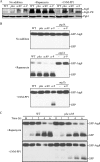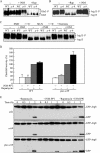Protein kinase A and Sch9 cooperatively regulate induction of autophagy in Saccharomyces cerevisiae
- PMID: 17699586
- PMCID: PMC1995722
- DOI: 10.1091/mbc.e07-05-0485
Protein kinase A and Sch9 cooperatively regulate induction of autophagy in Saccharomyces cerevisiae
Abstract
Autophagy is a highly conserved, degradative process in eukaryotic cells. The rapamycin-sensitive Tor kinase complex 1 (TORC1) has a major role in regulating induction of autophagy; however, the regulatory mechanisms are not fully understood. Here, we find that the protein kinase A (PKA) and Sch9 signaling pathways regulate autophagy cooperatively in yeast. Autophagy is induced in cells when PKA and Sch9 are simultaneously inactivated. Mutant alleles of these kinases bearing a mutation that confers sensitivity to the ATP-analogue inhibitor C3-1'-naphthyl-methyl PP1 revealed that autophagy was induced independently of effects on Tor kinase. The PKA-Sch9-mediated autophagy depends on the autophagy-related 1 kinase complex, which is also essential for TORC1-regulated autophagy, the transcription factors Msn2/4, and the Rim15 kinase. The present results suggest that autophagy is controlled by the signals from at least three partly separate nutrient-sensing pathways that include PKA, Sch9, and TORC1.
Figures






Similar articles
-
Rim15 and Sch9 kinases are involved in induction of autophagic degradation of ribosomes in budding yeast.Biosci Biotechnol Biochem. 2017 Feb;81(2):307-310. doi: 10.1080/09168451.2016.1234928. Epub 2016 Sep 23. Biosci Biotechnol Biochem. 2017. PMID: 27659307
-
TOR and PKA signaling pathways converge on the protein kinase Rim15 to control entry into G0.Mol Cell. 2003 Dec;12(6):1607-13. doi: 10.1016/s1097-2765(03)00485-4. Mol Cell. 2003. PMID: 14690612
-
Life span extension by calorie restriction depends on Rim15 and transcription factors downstream of Ras/PKA, Tor, and Sch9.PLoS Genet. 2008 Jan;4(1):e13. doi: 10.1371/journal.pgen.0040013. Epub 2007 Dec 13. PLoS Genet. 2008. PMID: 18225956 Free PMC article.
-
Interaction of TOR and PKA Signaling in S. cerevisiae.Biomolecules. 2022 Jan 26;12(2):210. doi: 10.3390/biom12020210. Biomolecules. 2022. PMID: 35204711 Free PMC article. Review.
-
The TORC1-Sch9 pathway as a crucial mediator of chronological lifespan in the yeast Saccharomyces cerevisiae.FEMS Yeast Res. 2018 Aug 1;18(5). doi: 10.1093/femsyr/foy048. FEMS Yeast Res. 2018. PMID: 29788208 Review.
Cited by
-
Replicative and chronological aging in Saccharomyces cerevisiae.Cell Metab. 2012 Jul 3;16(1):18-31. doi: 10.1016/j.cmet.2012.06.002. Cell Metab. 2012. PMID: 22768836 Free PMC article. Review.
-
Ribosomal protein S6 phosphorylation is controlled by TOR and modulated by PKA in Candida albicans.Mol Microbiol. 2015 Oct;98(2):384-402. doi: 10.1111/mmi.13130. Epub 2015 Aug 22. Mol Microbiol. 2015. PMID: 26173379 Free PMC article.
-
Intranasal Administration of Forskolin and Noopept Reverses Parkinsonian Pathology in PINK1 Knockout Rats.Int J Mol Sci. 2022 Dec 30;24(1):690. doi: 10.3390/ijms24010690. Int J Mol Sci. 2022. PMID: 36614135 Free PMC article.
-
Autophagic Proteome in Two Saccharomyces cerevisiae Strains During Second Fermentation for Sparkling Wine Elaboration.Microorganisms. 2020 Apr 6;8(4):523. doi: 10.3390/microorganisms8040523. Microorganisms. 2020. PMID: 32268562 Free PMC article.
-
A newly characterized vacuolar serine carboxypeptidase, Atg42/Ybr139w, is required for normal vacuole function and the terminal steps of autophagy in the yeast Saccharomyces cerevisiae.Mol Biol Cell. 2018 May 1;29(9):1089-1099. doi: 10.1091/mbc.E17-08-0516. Epub 2018 Mar 22. Mol Biol Cell. 2018. PMID: 29514932 Free PMC article.
References
-
- Beck T., Hall M. N. The TOR signalling pathway controls nuclear localization of nutrient-regulated transcription factors. Nature. 1999;402:689–692. - PubMed
-
- Chen J. C., Powers T. Coordinate regulation of multiple and distinct biosynthetic pathways by TOR and PKA kinases in S. cerevisiae. Curr. Genet. 2006;49:281–293. - PubMed
Publication types
MeSH terms
Substances
Grants and funding
LinkOut - more resources
Full Text Sources
Other Literature Sources
Molecular Biology Databases
Miscellaneous

